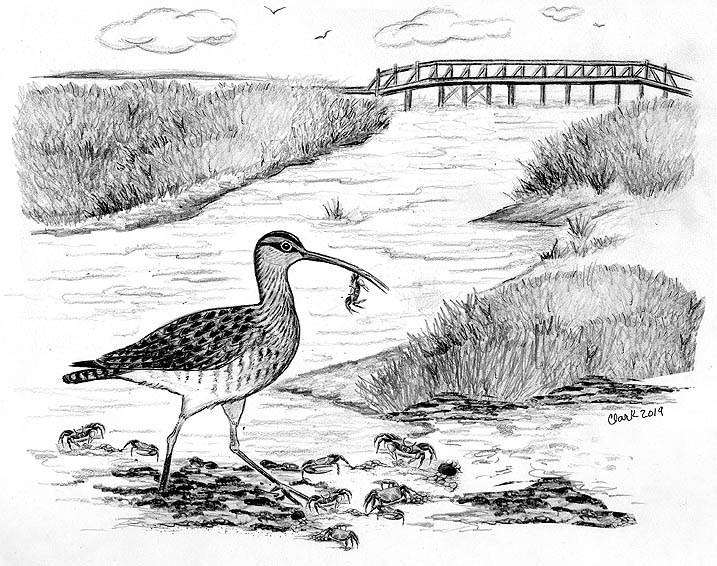
Whimbrels in Wellfleet,
When most beachgoers think of shorebirds, they probably picture the cutesy sandpipers they see playing tag with the waves. Those birds are actually called “Sanderlings,” but “cutesy sandpipers” works, too. Throughout the year, Cape Cod is visited by over thirty different species of sandpipers, some of which are considerably larger than Sanderlings. This is the case with the Whimbrel. Whimbrels are hefty in comparison, weighing nearly seven times more than Sanderlings. They have distinguishing stripes on their head and a very long bill, which curves noticeably downward. You will not confuse this bird with a Sanderling, or any other cutesy sandpipers.
Whimbrels spend their day hunting for fiddler crabs, especially in the marshes along Wellfleet Bay. But this year I had seen very few of these handsome birds. Then I ran into fellow birder, George Martin. George told me that the best place to see Whimbrels, as well as other shorebirds, is from Wellfleet’s Lieutenant Island bridge. Where? Why didn’t I know about this? I hate not knowing good birding places, but I didn’t waste time beating myself up about it. I was off to the bridge.
Lieutenant Island is a peculiar little section of Wellfleet. To begin with, no one seems to agree on the proper spelling of the name. I’ve routinely seen it written both Lieutenant Island and Lieutenant’s Island. For the sake of this column, I’ve decided to go with Lieutenant, as I’m too lazy to add the extra “s,” not to mention the apostrophe. The other unusual thing about the island is that it’s connected to the rest of the Cape by a short wooden bridge, which is only wide enough for a single vehicle to cross at a time. However, this one-way bridge is sometimes a “no-way bridge,” as extreme high tides can completely cover the access road. That’s scary. If you ever want to know the local tide schedule, ask a Lieutenant Islander. They always know.
On the morning I arrived, the tide was out and there were loads of shorebirds. But before I could even lift my binoculars, something happened. All of the birds instantly took to the air. The sky was filled with hundreds of Willets, yellow-legs, dowitchers, plovers and, yes, Whimbrels. I was a little bummed as I watched them all fly away. Why were they afraid of me? Didn’t they know who I am? (Or maybe they did.) Then I saw the reason for their panic. A Peregrine Falcon was cruising high above the marsh. Ordinarily, this would be a great sighting, but not right now. Fortunately, the speeding predator wasn’t in hunting mode and slowly the shorebirds returned. On a peat bank, north of the bridge, at least a dozen hungry Whimbrels settled down and began snacking on fiddler crabs. Old George was right; this bridge is indeed a good birding spot. There was just one problem. It was getting late and I had to go to work. I’ll be back.
A few days later I returned to the bridge, but this time the tide was high. Oops! The road wasn’t flooded, but the mudflats were under water, so there were no birds. I was just about to turn around when I saw famed hawk watcher, Don Manchester, coming towards me. I was glad to see Don, except I kept calling him “George.” (Apparently, I can only keep one name in my head at a time.) Don showed me his photos of “Ahanu,” a Whimbrel that had been trapped, banded and fitted with a transmitter in the same Wellfleet marsh a year ago, and now it was back. Don also introduced me to Brad Winn. Brad is the biologist from Manomet who banded Ahanu last September and has been tracking it ever since. On this particular day, Brad was there to meet a reporter from the Boston Globe, but while he was waiting for her, he was stuck talking to me. Poor Brad.
Brad enthusiastically answered my endless list of questions. He told me that over the past year he has tracked Ahanu (which means “he laughs” in Algonquin) from Wellfleet to the northern part of South America, and finally to Brazil, where it spent the winter. When spring arrived, the bird flew to the Texas coast, before continuing on to… Here is where things go fuzzy. A massive swarm of no-see-ums descended on me and my swatting caused me to lose focus. I believe Brad said something about the bird traveling to the breeding grounds in Canada’s Northwest Territories. Eventually, it headed south again, only making a brief stop near Hudson Bay, before returning to where it had been banded the year before, the marshes around Wellfleet. Brad estimated the round-trip was nearly 13,000 miles long. He said the trip should have been shorter, but the bird overshot the Cape. It made a quick stop on Martha’s Vineyard, before finally turning around and flying back to Wellfleet. Brad wasn’t sure of the reason for the brief Vineyard visit, but I knew why. Mad Martha’s Ice Cream, of course.
The Lieutenant Island bridge is a good place to look for Whimbrels (and other shorebirds), but keep a few things in mind. Don’t get in the way of the residents; they are trying to get home or go to work and don’t need gawking birders blocking their little bridge. August and September are the best months for birds, especially on the incoming tide. Neither dead low tide or peak high tide are likely to be very productive. And if you do see any Whimbrels, look for Ahanu. It will be easy to spot. It has a leg band with the letters “AHT” on it. But most importantly, it will be the only bird in the marsh with ice cream on its beak.